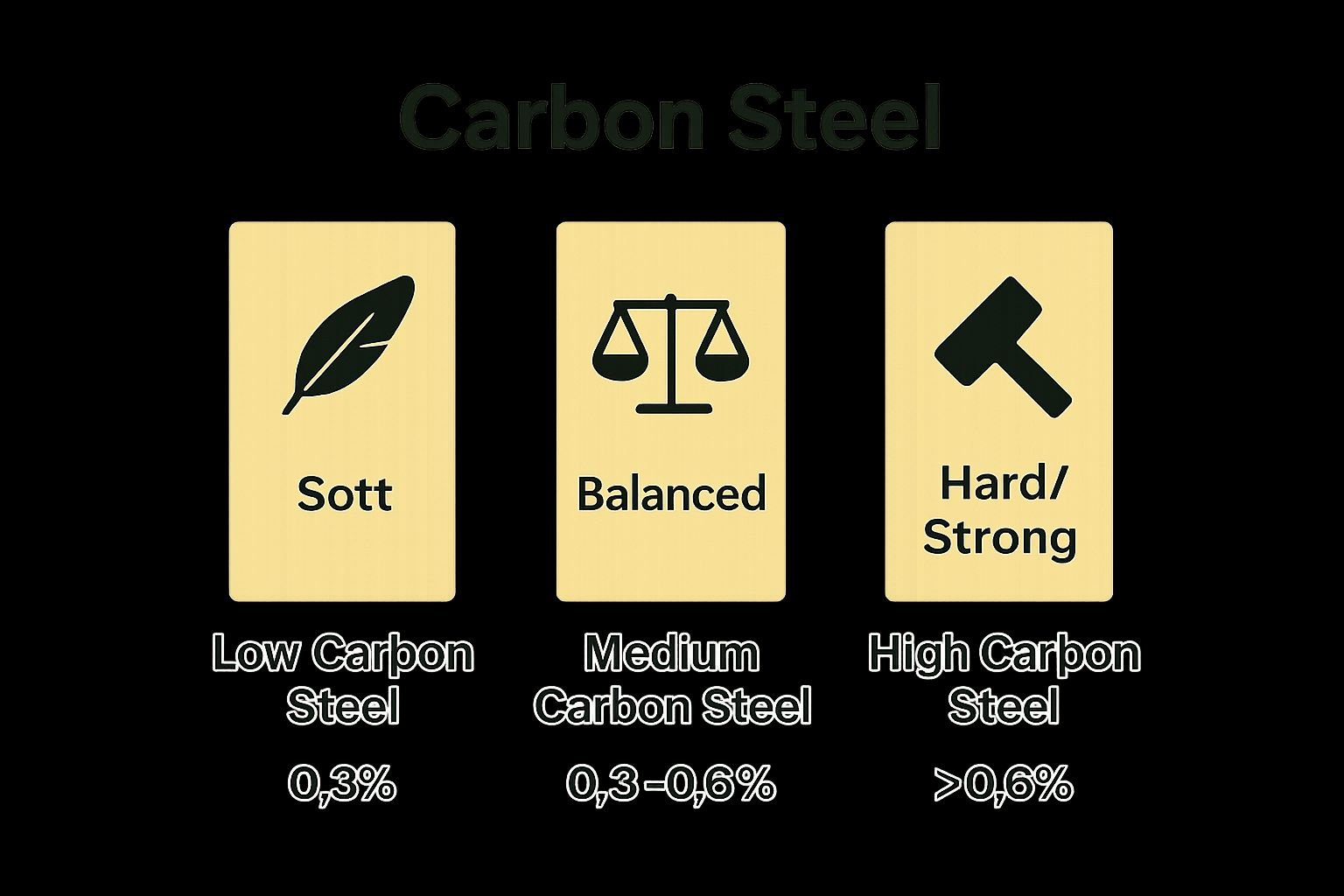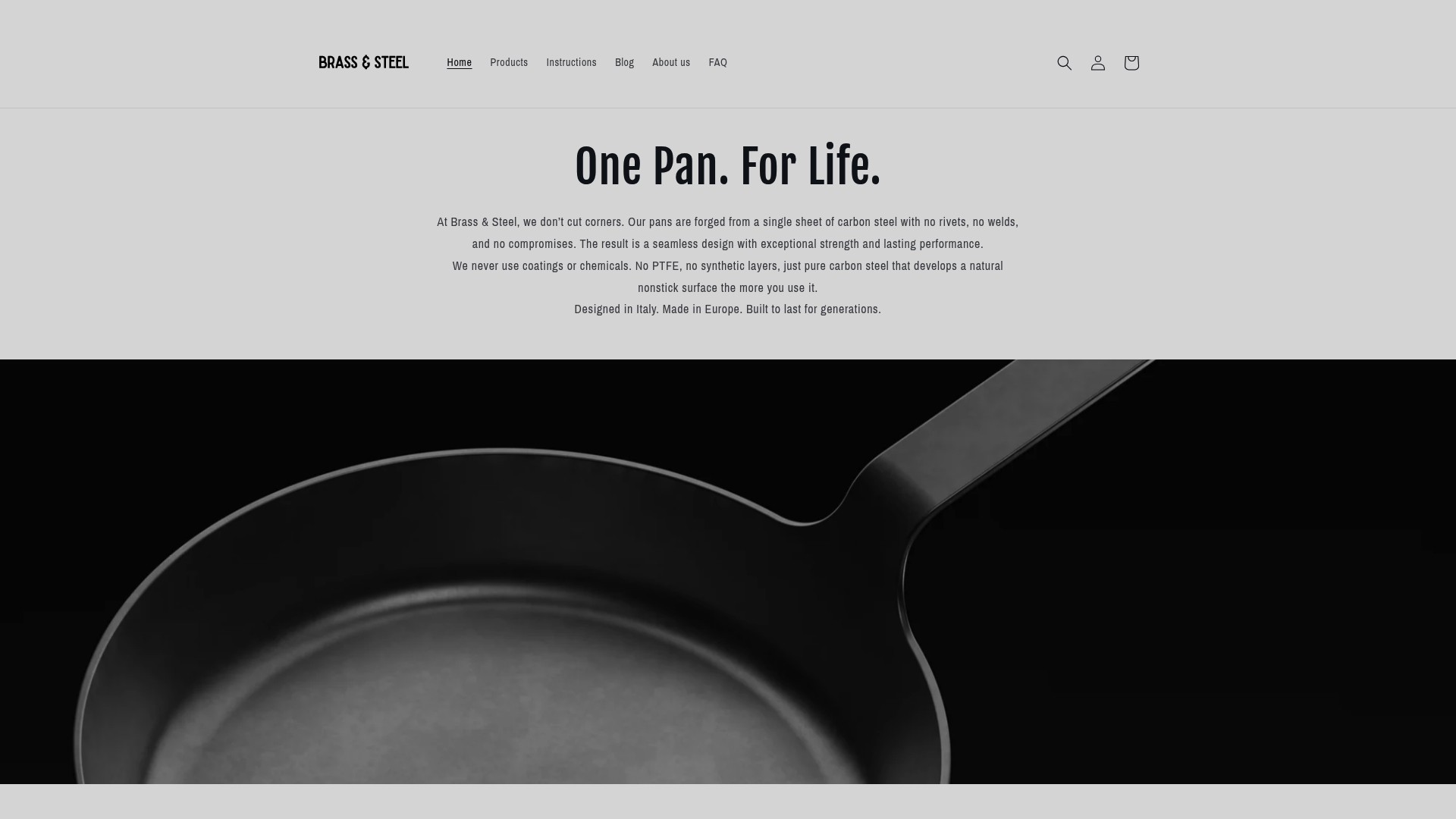
Understanding the Health Benefits of Carbon Steel Cookware
Share
Everyone talks about non-stick pans and trendy cookware, but carbon steel is quietly taking over kitchens across Britain. Imagine this. Carbon steel is made from up to 2.1 percent carbon by weight, a tiny amount that transforms ordinary iron into a cooking powerhouse. Most people assume its simplicity means outdated technology. The surprise is that this age-old material not only cooks better, but it also naturally avoids synthetic chemicals and preserves nutrients in ways modern pots simply cannot.
Table of Contents
- What Is Carbon Steel And Its Composition?
- Why Carbon Steel Cooking Tools Matter For Health?
- How Carbon Steel Influences Food Quality And Safety?
- Key Features Of Carbon Steel And Their Health Implications?
Quick Summary
| Takeaway | Explanation |
|---|---|
| Carbon content affects properties | The percentage of carbon in steel determines hardness, strength, and ductility, influencing its suitability for different applications. |
| Natural surface prevents contamination | Carbon steel’s seasoning process forms a protective layer, minimising the risk of metal leaching and avoiding synthetic coatings. |
| Uniform heat distribution enhances cooking | The excellent thermal conductivity of carbon steel ensures even heat, which helps maintain food quality and nutritional integrity during cooking. |
| Supports health-conscious cooking | By providing a chemical-free cooking surface and preserving nutrients, carbon steel cookware promotes healthier cooking methods and sustainability. |
| Durability makes it a smart investment | The longevity and resilience of carbon steel cookware make it an economically viable choice for both home cooks and professionals. |
What is Carbon Steel and Its Composition?
Carbon steel represents a foundational metal alloy with remarkable versatility across numerous applications, particularly in cookware manufacturing. According to materials science research, carbon steel is primarily an iron and carbon composite with carbon content ranging between 0.05% and 2.1% by weight.
The Essential Composition of Carbon Steel
At its core, carbon steel is distinguished by its fundamental composition. Unlike stainless steel, which incorporates additional alloying elements like chromium and nickel, carbon steel maintains a more straightforward metallurgical profile. The primary components include:
- Iron as the primary metal
- Carbon as the key alloying element
- Trace amounts of other potential elements
The percentage of carbon dramatically influences the steel’s mechanical properties. Research from metallurgy experts categorizes carbon steels into three primary classifications based on carbon concentration:

- Low Carbon Steel: Contains up to 0.3% carbon
- Medium Carbon Steel: Ranges between 0.3% and 0.6% carbon
- High Carbon Steel: Comprises above 0.6% carbon content
Why Carbon Percentage Matters
The carbon concentration directly impacts the steel’s fundamental characteristics. Higher carbon percentages typically result in increased hardness and strength, but simultaneously reduce ductility. This nuanced relationship between carbon content and material properties makes carbon steel an exceptionally adaptable material.
In cookware manufacturing, these metallurgical principles translate into cookware with exceptional heat conductivity, durability, and natural nonstick properties. Learn more about carbon steel pan characteristics to understand how these compositional details influence cooking performance.
Carbon steel’s remarkable versatility stems from its ability to be engineered for specific applications by carefully controlling its carbon content, making it a material that bridges traditional metallurgy with modern manufacturing requirements.
Below is a comparison table outlining the differences between the main carbon steel categories based on their carbon content and properties, as discussed in the article.
| Carbon Steel Category | Carbon Content | Key Properties | Common Usage in Cookware |
|---|---|---|---|
| Low Carbon Steel | Up to 0.3% | High ductility, lower hardness and strength | Rarely used for pans due to softness |
| Medium Carbon Steel | 0.3% to 0.6% | Balanced hardness, strength and ductility | Used for general-purpose cookware |
| High Carbon Steel | Above 0.6% | High hardness and strength, reduced ductility | Used in specialty, high-performance pans |
Why Carbon Steel Cooking Tools Matter for Health?
Carbon steel cookware represents a significant advancement in health-conscious cooking technology, offering numerous advantages over traditional non-stick and synthetic cooking surfaces. Research from nutritional science highlights the potential health benefits of using minimally processed cooking materials.
Chemical-Free Cooking Surface
Unlike conventional non-stick cookware that relies on synthetic chemical coatings, carbon steel provides a natural cooking surface that develops a protective seasoning through repeated use. This unique characteristic means:
- No synthetic chemical coatings
- Minimal risk of toxic metal leaching
- Natural non-stick properties developed organically
The seasoning process creates a polymerised oil layer that acts as a protective barrier, preventing direct metal contact with food and enhancing the cooking experience.
Nutritional Integrity and Cooking Performance
Carbon steel cookware supports nutritional integrity by maintaining stable cooking temperatures and minimising potential chemical interactions. Explore our comprehensive carbon steel safety guide to understand the scientific principles behind this innovative cooking technology.
Key nutritional advantages include:
- Even heat distribution
- Reduced risk of potential chemical contamination
- Preservation of food’s natural flavours and nutrients
Additionally, carbon steel’s remarkable thermal conductivity ensures rapid and uniform heating, which can help preserve nutritional content by reducing cooking times and maintaining optimal cooking temperatures.
The health benefits extend beyond immediate cooking considerations. By choosing carbon steel, consumers invest in cookware that supports long-term wellness through sustainable, chemical-free cooking practices. The material’s durability and minimal processing make it an environmentally conscious choice for health-aware individuals seeking high-performance cooking solutions.
The following table summarises the core health and performance characteristics of carbon steel cookware, making it easier to understand its advantages for health-conscious cooking.
| Feature/Characteristic | Health & Cooking Implication |
|---|---|
| Chemical-Free Cooking Surface | No synthetic coating, minimal risk of toxic leaching |
| Seasoned Natural Non-Stick Layer | Reduces direct metal contact, improves non-stick, organic protection |
| Excellent Thermal Conductivity | Uniform heat, promotes even cooking and nutrient preservation |
| Minimal Metal Reactivity | Low potential for chemical interaction with food |
| Durable & Long-Lasting | Withstands frequent use, sustainable and cost-effective |
| Easy Maintenance | Seasoning process rejuvenates surface, easy to keep safe |
How Carbon Steel Influences Food Quality and Safety?
Research on food safety materials reveals that carbon steel offers unique advantages in maintaining food quality and safety through its inherent metallurgical properties. Unlike synthetic cookware, carbon steel provides a natural, reactive surface that evolves with cooking practices.
Natural Surface Interactions
Carbon steel’s cooking surface undergoes a transformative process called seasoning, which creates a protective molecular layer that dramatically influences food preparation. This natural mechanism ensures:
- Minimal chemical interactions with food
- Gradual development of non-stick properties
- Enhanced flavour preservation
The seasoning process involves polymerisation of cooking oils, which creates a stable, smooth surface that reduces direct metal contact with ingredients. This organic coating acts as a natural barrier, preventing potential metal ion transfer and supporting a cleaner cooking environment.
Thermal and Nutritional Performance
The material’s exceptional thermal conductivity plays a critical role in food safety and quality. Carbon steel distributes heat uniformly, reducing potential hot spots that might compromise nutritional integrity or create uneven cooking conditions.
Key performance characteristics include:
- Rapid and consistent heat distribution
- Ability to reach high temperatures quickly
- Minimal nutrient degradation during cooking
Learn more about cooking techniques with carbon steel to understand how professional chefs leverage these unique properties.
Carbon steel’s natural composition ensures that cooking remains a pure, uncontaminated experience. By eliminating synthetic coatings and promoting a self-maintaining surface, carbon steel represents a sophisticated approach to health-conscious cooking that prioritises ingredient quality and safety.
Key Features of Carbon Steel and Their Health Implications?
Scientific research in materials engineering highlights carbon steel’s remarkable properties that directly influence cooking safety and nutritional preservation. Understanding these intrinsic characteristics helps consumers make informed cookware choices.
Molecular Structure and Health Interactions
Carbon steel’s unique molecular composition provides inherent health advantages through its minimalistic metallic structure. The fundamental properties include:
- Low reactivity with food ingredients
- Natural resistance to chemical contamination
- Self-regenerating protective surface layer
The material’s low reactivity means reduced potential for unwanted chemical interactions during cooking, which distinguishes it from synthetic cookware materials that might leach harmful substances.
Thermal Conductivity and Nutrient Preservation
Carbon steel’s exceptional thermal properties play a critical role in maintaining food quality. Rapid and uniform heat distribution ensures:
- Consistent cooking temperatures
- Reduced cooking times
- Minimal nutritional degradation
Explore our comprehensive guide to carbon steel health benefits to understand the sophisticated science behind these cooking advantages.
The material’s ability to rapidly transfer and distribute heat helps preserve delicate nutrients that might otherwise break down under prolonged or uneven heating conditions. This characteristic makes carbon steel an excellent choice for health-conscious home cooks and professional chefs seeking optimal nutritional outcomes.

Experience True Health with Carbon Steel Cookware by Brass & Steel
Are you searching for cookware that supports your health and lets you cook with absolute confidence? The article you just read highlighted the hidden risks in synthetic non-stick pans and explained why carbon steel is ideal for anyone wanting chemical-free, nutrient-preserving cooking. You value a natural nonstick pan that is free from synthetic coatings and harmful substances. You seek better heat distribution and peace of mind for you and your family. Brass & Steel is the answer.
Explore our Carbon Steel Collection to discover professional-grade pans engineered with single-piece forged construction and a pure naturally seasoned surface. Our designs eliminate rivets and welds for the ultimate in food safety and easy cleaning.

Upgrade your kitchen today by choosing health-conscious, PTFE-free cookware trusted by chefs and home cooks. Visit Brass & Steel and make the switch to high-performance carbon steel pans that enhance both flavour and wellbeing. Your journey to responsible cooking starts now.
Frequently Asked Questions
What are the health benefits of using carbon steel cookware?
Carbon steel cookware offers a natural cooking surface that develops a protective seasoning over time, eliminating the risk of synthetic chemical leaching and promoting healthier cooking practices.
How does carbon content in carbon steel affect its properties?
The carbon content significantly influences the hardness, strength, and ductility of the steel. Higher carbon concentrations generally result in increased toughness and better heat conductivity, making it ideal for cookware.
Is carbon steel cookware safe for cooking?
Yes, carbon steel cookware is considered safe. It doesn’t contain synthetic coatings and develops a natural non-stick surface, ensuring minimal chemical interactions with food during cooking.
How do I maintain carbon steel cookware to ensure its longevity?
To maintain carbon steel cookware, ensure proper seasoning after each use, avoid soaking in water, and dry it immediately. Regularly applying a thin layer of oil helps preserve its protective surface and cooking performance.